 W
WAbdounodus is an extinct genus of mammal known from the middle Paleocene of northern Africa. The sole species, A. hamdii, is known from teeth discovered in the Ouled Abdoun Basin of present-day Morocco in 2001. Traditionally considered a mioclaenid "condylarth", recent studies place it as a basal afrothere closely related to Ocepeia, demonstrating the close convergent evolution between perissodactyls and herbivorous afrotheres and bridging paenungulates with other afrotheres.
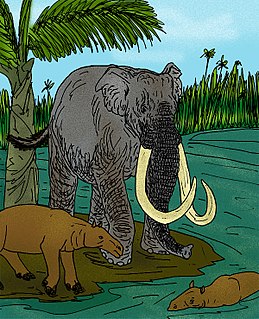 W
WThe African mammoth, Mammuthus africanavus, is the second oldest mammoth species, having first appeared around 3 million years ago during the late Pliocene, with a last appearance around 1.65 million years ago in the early Pleistocene. Its fossils have been found in Chad, Libya, Morocco and Tunisia. It was relatively small and is seen as the direct ancestor of M. meriodionalis, although its tusk diverged more widely from its skull than later species of mammoth, which might indicate that it was an evolutionary dead end.
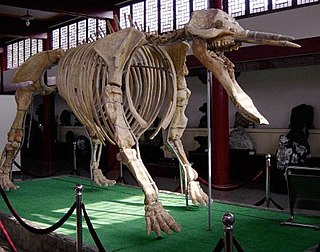 W
WAmebelodontidae is an extinct family of large herbivorous mammals that were closely related to elephants. They were formerly assigned to Gomphotheriidae, but recent authors consider them a distinct family.
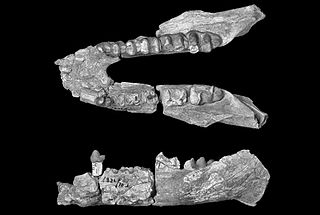 W
WArcanotherium is an extinct genus of early proboscidean belonging to the family Numidotheriidae that lived in north Africa during the late Eocene/early Oligocene interval.
 W
WArchaeobelodon is an extinct genus of proboscidean of the family Amebelodontidae that lived in Europe and North Africa (Egypt) during the Miocene from 16.9—16.0 Ma, living for approximately 0.9 million years.
 W
WBarytheriidae is an extinct family of primitive proboscideans that lived during the late Eocene and early Oligocene in North Africa and Oman. The Barytheriidae were the first large-sized proboscideans to appear in the fossil record and were characterized by a strong sexual dimorphism.
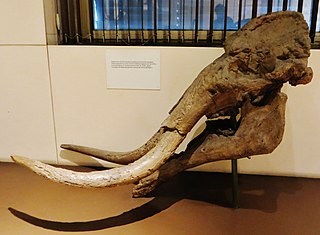 W
WChoerolophodon is an extinct genus of proboscid which lived during the Miocene of Eurasia and Africa.
 W
WChoerolophodontidae is an extinct family of large herbivorous mammals that were closely related to elephants. Two genera are known, Afrochoerodon and Choerolophodon.
 W
WCrivadiatherium is an extinct genus of Palaeoamasiidae, which fossil remains—teeth and mandible fragments—have been discovered in the Crivadia site in the Hațeg depression, Romania. The age of the Crivadia site is not clear, but seems to be between the Late Eocene to the Early Oligocene. The teeth of Crivadiatherium, compared with those of its relatives as Palaeoamasia from Turkey and Arsinoitherium from Egypt, shows features more primitive, with lower molars without lobes and less bilophodont. It is probable that Crivadiatherium lived in lacustrine environments, maybe eating abrasive plants.
 W
WDaouitherium is an extinct genus of early proboscideans that lived during the early Eocene some 55 million years ago in North Africa.
 W
WDilambdogale is an extinct genus of afrosoricid which existed in Fayum, Egypt during the latest Eocene. It was first named by Erik R. Seiffert in 2010 and the type species is Dilambdogale gheerbranti. Dilambdogale is the oldest known afrosoricid and its closest relative was Widanelfarasia.
 W
WDusisiren is an extinct genus of dugong related to the Steller's sea cow that lived in the North Pacific during the Neogene.
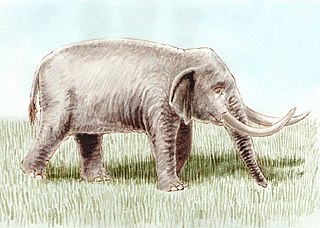 W
WElephas beyeri is an extinct species of dwarf elephant belonging to the Elephantidae family of the Middle Pleistocene. It was named after the anthropologist H. Otley Beyer. The type specimen was discovered on Cabarruyan Island in The Philippines but has since been lost.
 W
WElephas hysudricus is an extinct elephant species and was described from fossil remains found in the Siwalik hills. It lived during the Pliocene and Pleistocene epochs.
 W
WEosiren is an extinct genus of sea cow that lived during the Late Eocene to Early Oligocene (Rupelian). Several fossils have been found in Egypt. It seems like the species E. abeli were contemporaneous with Protosiren and Eotheroides. like them, Eosiren closely resembled modern sirenians. It differes from them by having somewhat larger innominates and possess thigh bones.
 W
WEubelodon is an extinct genus of gomphothere which lived in North America during the Miocene Epoch. It contains a single species: Eubelodon morrilli. Like other gomphotheres it had a superficially elephant-like appearance with a trunk and tusks.
 W
WKaupitherium is an extinct dugongid sea cow that lived during the Oligocene. Fossils of the genus have been found in the Alzey Formation of Germany. Inside its flippers were finger bones that did not stick out. Kaupitherium also had the residues of back legs, which did not show externally. However, it did have a basic femur, joined to a reduced pelvis. Kaupitherium also had elongated ribs, presumably to increase lung capacity to provide fine control of buoyancy.
 W
WKonobelodon is a genus of amebelodont from southern Europe, China, and North America.
 W
WKvabebihyrax kachethicus is an extinct hyrax from the Pliocene of the Caucasus.
 W
WLoxodonta atlantica is an extinct species of elephant in the genus Loxodonta, from Africa. It was larger than the modern African elephant, with more progressive dentition. It includes Pleistocene fossils from Ternifine, Middle Pleistocene fossils from Elandsfontein and Late Pliocene fossils from the Omo River, with a final dating in the Late Pleistocene. L. atlantica was said to probably derive from L. adaurora; however, an analysis in 2009 suggested that L. atlantica evolved from L. exoptata, and is ancestral to L. africana. The species is divided into two subspecies: L. atlantica atlantica and L. atlantica zulu. The type for Loxodonta atlantica is housed in the Muséum national d'histoire naturelle in Paris, but is listed without a specimen number.
 W
WMammuthus creticus, or the Cretan dwarf mammoth, is an extinct species of dwarf mammoth. With a shoulder height of about 1 m and a weight of about 310 kg, it was the smallest mammoth that ever existed.
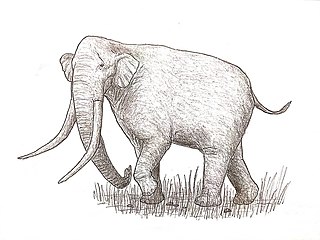 W
WMammuthus subplanifrons, the South African Mammoth, is the oldest representative of the genus Mammuthus, appearing around 5 million years ago during the early Pliocene in what is today South Africa and countries of East Africa, especially Ethiopia. They already presented some of the unique characteristics of mammoths like the spirally, twisting tusks. It was 3.68 metres (12.1 ft) tall at the shoulder and weighed about 9 tonnes. In 2009, it was shown that Loxodonta adaurora is indistinguishable from Mammuthus subplanifrons. The continuously decreasing length of vertebral spines from shoulder to hip and the extreme femur to tibia ratio indicate that this species belongs to Mammuthus, not Loxodonta, and since Mammuthus subplanifrons was named first, that would be the valid name for the species.
 W
WMegabelodon is an extinct gomphotherid genus of proboscid which inhabited North America in from the Miocene to the Pliocene. Specimens were found in Nevada and New Mexico. The genus has been disputed, with some paleontologists considering Megabelodon as a synonym of Gomphotherium.
 W
WMiosiren is an extinct genus of manatee from the Early Miocene of southeastern England (Suffolk) and Antwerp, Belgium.
 W
WPachyhyrax was a genus of herbivorous hyrax-grouped mammal belonging to the clade Paenungulata.
 W
WPalaeoloxodon mnaidriensis or Elephas mnaidriensis is an extinct species of elephant from Malta and Sicily closely related to the modern Asian elephant, or possibly to the modern African forest elephant. This elephant is a separate species with respect to the European mainland straight-tusked elephant and not just a smaller insular form. P. mnaidriensis has nearly 90% body reduction compared to the ancestral form with an estimated shoulder height of about 1.8 metres (5.9 ft) and a mean body weight of about 1,100 kilograms (2,400 lb). Another estimate gives a shoulder height of 2 m (6.6 ft) and a weight of 1.7 t.
 W
WPalaeomastodon an extinct genus of Proboscidea. Palaeomastodon fossils have been found in Africa, lived some 36-35 million years ago. They are believed to be the ancestors of elephants or mastodons. Palaeomastodon lived in marshy semi aquatic swamps during the middle late Eocene to the early Oligocene. It may have used its upper pair of tusks for scraping bark off trees. Palaeomastodon was a very early form of the elephantidae and thus had a very short trunk.
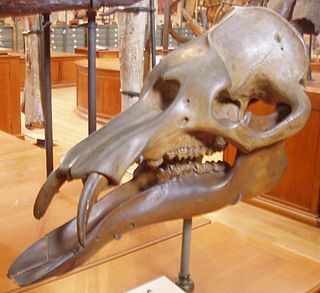 W
WPhiomia is an extinct genus of basal proboscid that lived in what is now Northern Africa during the Late Eocene to Early Oligocene some 37–30 million years ago. "Phiomia serridens" means "saw-toothed animal of Faiyum".
 W
WPlatybelodon was a genus of large herbivorous mammals related to the elephant. It lived during the middle Miocene Epoch in Africa, Asia and the Caucasus.
 W
WPlesielephantiformes is an extinct clade of large herbivorous mammals and one of two suborders of the Proboscidea, a group containing elephants and their close relatives.
 W
WPliohyrax, is a genus of hyracoids. It grew to sizes greatly exceeding those of any living hyrax, though it was by no means the largest member of this family.
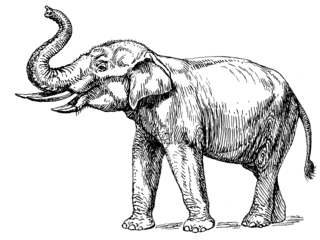 W
WPrimelephas is a genus of Elephantinae that existed during the Miocene and Pliocene epochs. The name of the genus suggests 'first elephant'. These primitive elephantids are thought to be the common ancestor of Mammuthus, the mammoths, and the closely allied genera Elephas and Loxodonta, the Asian and African elephants, diverging some 4-6 million years ago. It had four tusks, which is unusual for an elephant. The type species, Primelephas gomphotheroides, was described by Vincent Maglio in 1970, with the specific epithet indicating the fossil specimens were gomphothere-like. Primelephas korotorensis is the only other species to be assigned to the genus.
 W
WProgomphotherium is an extinct genus of large herbivorous mammals that were closely related to elephants.
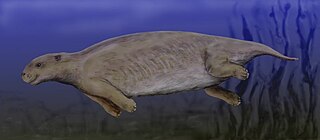 W
WProrastomidae is a family of extinct sirenians from Jamaica, related to the extant manatees and dugong. The family includes the oldest known fossils of Sirenians, represented in two genera:Pezosiren
 W
WProrastomus sirenoides is an extinct species of primitive sirenian that lived during the Eocene Epoch 40 million years ago in Jamaica.
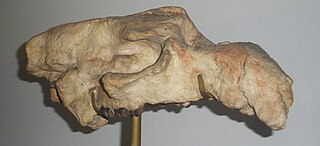 W
WPrototherium is a genus of extinct sirenian related to the dugong. It is known from middle (Bartonian) and upper Eocene deposits in Italy and Spain. Type species is P. veronenses
 W
WPtolemaia is a genus of extinct Afrotherian mammals from the Oligocene of East Africa. The genus and type species, P. lyonsi, was described by Henry Fairfield Osborn in 1908 from the Jebel Qatrani Formation of Egypts' Fayum Depression. The genus name alludes to the Ptolemaic dynasty of Ancient Greece which ruled over the Egyptian region where Ptolemaia was discovered, while the specific epithet lyonsi honors H. G. Lyons, then director of the Egyptian Geological Survey. A second species, P. grangeri, was described in 1987, and named after the early 20th century paleontologist Walter W. Granger. Fossils of P. grangeri are also known from Kenya.
 W
WPtolemaiida is a taxon of wolf-sized afrothere mammals that lived in northern and eastern Africa during the Paleogene. The oldest fossils are from the latest Eocene strata of the Jebel Qatrani Formation, near the Fayum oasis in Egypt. A tooth is known from an Oligocene-aged stratum in Angola, and Miocene specimens are known from Kenya and Uganda
 W
WRhynchotherium is an extinct genus of proboscidea endemic to North America and Central America during the Miocene through Pliocene from 13.650—3.6 Ma, living for approximately 10 million years.
 W
WRytiodus is an extinct genus of sirenian, whose fossils have been discovered in France, Europe and Libya.
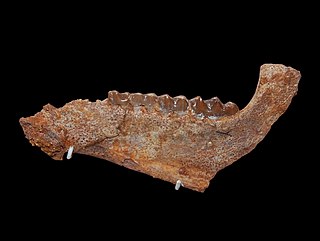 W
WSaghatherium was a genus of herbivorous hyrax that lived during the Oligocene period and what is now in Egypt, Libya and Oman.
 W
WSerbelodon is an extinct genus of proboscidean. It had tusks and a trunk. It lived in North America during the Miocene Epoch, and it was closely related to Amebelodon. They had a diet that consisted of C3 plants which include fruits, tree cortex, herbs, and leaves.
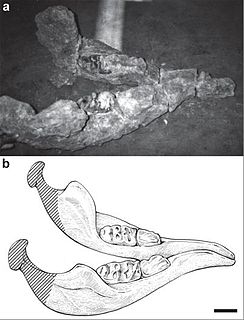 W
WSinomammut is a proboscidean found in the Miocene of China. It was known from a single, fragmentary, mandible found in the 1990s. However, most of the specimen has been lost, leaving only the right ramus and an in-situ photograph of the mandible. The mandible was originally thought a gompothere closely related to Sinomastodon, but an analysis revealed it to actually be a mammutid that was a sister group to the well-known mastodon. It can be distinguished from the mastodon by its lack of lower tusks.
 W
WStegodibelodon is an extinct genus of elephant or gomphothere from the Miocene.
 W
WStegolophodon is an extinct genus of stegodontid proboscideans, with two tusks and a trunk. It lived during the Miocene and Pliocene epochs, and may have evolved into Stegodon. Fossils have been primarily found in Asia, but some have also been reported in Africa.
 W
WStegosiren was an early sea cow from the Middle Oligocene of South Carolina, USA. It shows a stage of halitheriine evolution more derived than that of the Old World early Oligocene Eosiren imenti and Halitherium schinzii.
 W
WStegotetrabelodon is an extinct genus of primitive elephant with gomphothere-like anatomical features from the Late Miocene to Early Pliocene of Africa and Eurasia and the arabian peninsula. The type species is S. syrticus of late Miocene Africa, which reached roughly 4 m (13.1 ft) in shoulder height and 11–12 tonnes in weight. The other unequivocally recognized species is S. orbus, also of late Miocene Africa. Other species outside of Africa are questionably placed in this genus, including teeth from Late Miocene Hungary and Iran originally described as being of the Mastodon subgenus Bunolophodon, Chinese specimens originally described as being also of Mastodon, as well as of Tetralophodon and Stegodon, and a species from the late Miocene-aged Dokh Pathan Formation in Pakistan, S. maluvalensis.
 W
WTitanohyrax is an extinct genus of large to very large hyrax from the Eocene and Oligocene. Specimens have been discovered in modern-day Algeria, Tunisia, Egypt and Libya. Some species, like T. ultimus, are estimated to be as large as a rhinoceros. Titanohyrax species are still poorly known due to their rarity in the fossil record.
 W
WZygolophodon is an extinct genus of African, Asian, and European mammutid that lived from the Miocene to the Late Pliocene.